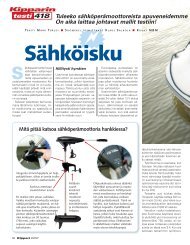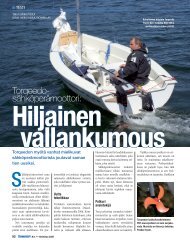1 2 3 - Torqeedo
1 2 3 - Torqeedo
1 2 3 - Torqeedo
Create successful ePaper yourself
Turn your PDF publications into a flip-book with our unique Google optimized e-Paper software.
<strong>Torqeedo</strong> Cruise<br />
Highly efficient and powerful – <strong>Torqeedo</strong> presents the<br />
The most powerful 24 V outboard on the market<br />
With the thrust force of a 6 HP combustion engine, the<br />
<strong>Torqeedo</strong> Cruise is the emission-free alternative for sailing and<br />
motor boats with displacement of up to three tons.<br />
Equipped with the latest torque technology, an optimized drive<br />
train and an optimized propeller, the <strong>Torqeedo</strong> Cruise is not only<br />
the most efficient but also the most powerful 24-volt outboard<br />
available on the market.<br />
The Cruise gets its energy either from lead batteries that have<br />
been connected in series (normally two 12 V batteries) or from<br />
the <strong>Torqeedo</strong> Power, lithium-based batteries.<br />
When using lead batteries within the power range of the Cruise,<br />
the efficiency of a drive is important for two reasons. On the<br />
one hand, an efficient drive converts the used energy better<br />
into propulsive force. A high efficiency of the drive additionally<br />
ensures that more battery capacity is available for consumption:<br />
The more efficient a drive is, the more it prevents the effectively<br />
available battery capacity from being reduced due to<br />
unnecessarily high power intake (compare here the Background<br />
Knowledge on Calculating the Range of Electric Motors on Page<br />
24 as well as the chapter on Battery Technology, on Pages 8/9).<br />
Due to the extraordinary efficiency of the Cruise, it wastes<br />
comparably little energy but its input power of 2,000 Watt is<br />
challenging to the lead battery supply. To compensate for the<br />
high-current characteristics and the loss of capacity of lead<br />
batteries concomitant to this, it is recommendable that you<br />
purchase lead batteries with comparably „good“ high-current<br />
characteristics as well as high rated capacities (ideally 4,800 Wh,<br />
i.e. two times 12 V / 200 Ah or higher rated capacities; compare<br />
Background Knowledge on Calculating the Range of Electric<br />
Motors on Page 24).<br />
Cable set for Cruise 2.0<br />
The cable set for the Cruise 2.0, available as an<br />
optional extra, allows for a simple and safe<br />
connection of the motor. The cable set is comprised<br />
of high-current resistant connection cable<br />
with 35mm 2 cross-sectional area, highcurrent<br />
plugs, a main switch, a fuse, battery<br />
connections and a battery connection cable for<br />
serial connection of two 12 V batteries.<br />
The cable set allows the motor to be connected<br />
to batteries up to 3 m away from it. A 2 m cable<br />
extension is available for larger distances.<br />
Background information on the voltage indicator:<br />
The <strong>Torqeedo</strong> Cruise 2.0 is designed to work with a nominal voltage of 24 volts in the form of two connected-in-series 12-volt<br />
batteries. When using new lead-gel batteries, the actual measured voltage depicted in the voltage indicator should range<br />
between 27 volts in a loaded state and 20 volts in an almost empty state.<br />
The voltage range between full and empty batteries, however, depends greatly on the batteries used. For this reason, the use<br />
of the voltage indicator as an indicator of the charge state of the connected batteries requires some getting used to, and is<br />
imprecise. If the batteries are not to be included in a more complicated measuring system, however, the voltage indicator<br />
remains the best indicator for calculating the remaining residual capacity of the batteries; hence, it is integrated in the Cruise<br />
models.<br />
Catalogue 2007<br />
27









